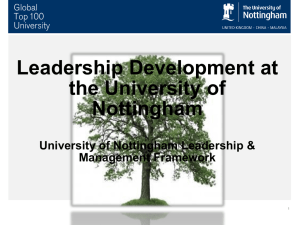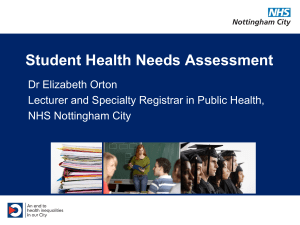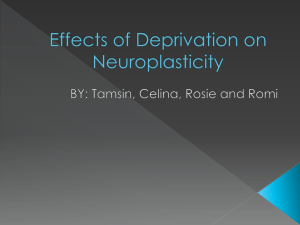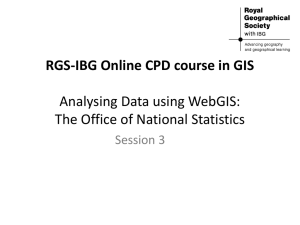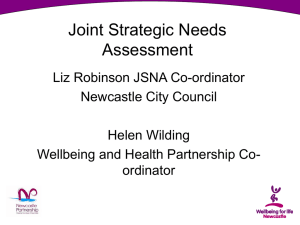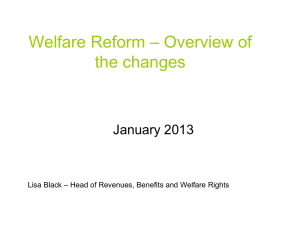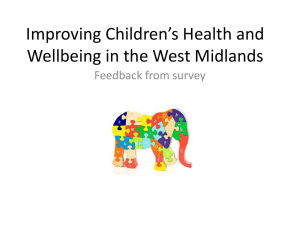presentation - Nottingham Community and Voluntary Service
advertisement
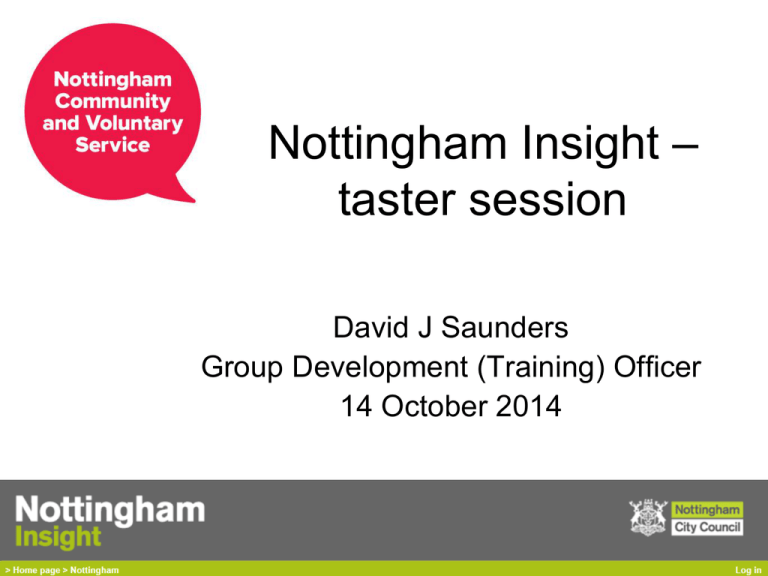
Nottingham Insight – taster session David J Saunders Group Development (Training) Officer 14 October 2014 Not a training session. This is a taster session to introduce you to… Aims of the session • Why should you attend? If you are interested in the 'Looking After Each Other' agenda or perhaps 'Small Steps Big Changes', or if you lead on any other project, then sooner or later you will be looking for evidence to demonstrate the need for your work or project. Nottingham Insight is the invaluable shared evidence base, providing access to data about Nottingham and its people. • How will it benefit you? You will experience a taste of what Insight can offer you, appreciate the complexity of it, then be shown the quick way to access the information which will benefit your organisation and its beneficiaries. You will also be introduced to other potential sources of evidence. Nottingham’s priorities Funders ask: • How does your work align with key strategies and priorities of your Local Authority? • Which local strategies does your project support? Need • The starting point for any project is to be clear on the needs it is addressing. Need is the term we use to describe a problem or issue, or situation where something needs to change to make things better, for a person, a group of people, an environment or an organisation. (Big (Lottery) Learning Zone) Need - key points checklist • What is the problem or issue you want to address with your project? • What evidence is there that this need exists? • What are the reasons for the need? • Have you carried out any research? • Why have you prioritised this need? • Why is your project an appropriate response to the need? (Big Lottery learning zone) • Where do YOU find evidence to demonstrate need? What is Nottingham Insight? • Nottingham Insight contains a wide range of: • Statistics and policies - City of Nottingham and Nottinghamshire. • Shared evidence base Nottingham City Council Clinical Commissioning Group (NHS) Census • Providing access to data, information and intelligence about Nottinghamshire. • The site is regularly used by a range of statutory organisations to inform the future priorities for the City of Nottingham and Nottinghamshire. Nottingham Insight • http://www.nottinghaminsight.org.uk/ JSNA Step 2 • Nottingham's needs Joint Strategic Needs Assessment (JSNA) The JSNA tells a story of communities in terms of their health and well-being. The JSNA in Nottingham helps the local authority, Primary Care Trust and Local Strategic Partnership to better understand the needs of the population so they can plan and organise services. Demonstrate Step 2 - Find out: • CHILD: What is the estimated number of disabled children in the city? • There are estimated to be about 4,000 disabled children and young people, aged 0-19, of which almost 900 have severe and lifelong disabilities. • JSNA: Children / Disability / Level of need / Para 1 • CHILD: How many Children in Care could there be by 2014/2015? • Could exceed 600 • JSNA: Children in Care / Section 2 Quiz 1. How many adults in Nottingham are estimated to have a 46,000 common mental health problem? (40,000) (23,000 req trt) 2. What is the estimated number of adult frequent drug users in the city? 3. What is the estimated number of adults with a moderate/severe learning disability in Nottingham? 4. What is the estimated number of asylum seekers in Nottingham? 5. Teenage pregnancy. The national average is 41.4 conceptions per 1000 girls aged 15 – 17. What is the average for Nottingham? 6,966 (3.3%) 1,293 adults 800 - 1000 adults (7,000 – 8,000 Refugees) 58.5 / 1000 Geography of: City Localities Areas Wards Super Output areas 3 8 20 176 IMD In England SOA 32,482 32,482 is classed as least deprived, 1 is the most Lower Super Output Areas • Super Output Areas are made up from groups of Output Areas and are generally the smallest area for which data is available • Lower Super Output Areas have an average of 678 households in Nottinghamshire (& about 1500 residents) 32,482 Three Rivers area of Chorleywood, Herts Aspley 97th 9/10 worst 10% 1 scoring 10th for Education & Skills IMD Index of Multiple Deprivation • A range of statistical indicators have been collected and grouped under seven domains. • The overall score, the Index of Multiple Deprivation (or IMD), is calculated from the domain results. Some domains carry more weight in the overall score than others. New IMD will be released Summer 2015 Table 1: Domain and Weights for the IMD 2010 Domain Domain weight Income deprivation 22.5% Employment deprivation 22.5% Health deprivation and disability 13.5% Education, skills and training deprivation 13.5% Barriers to housing and services 9.3% Crime 9.3% Living environment deprivation 9.3% In addition, there are two supplementary age-specific Indices • Income Deprivation Affecting Children • Income Deprivation Affecting Older People Step 4: Nottingham's Population The statistics below provide information on trends affecting Nottingham’s population. This information is potentially useful for organisations wishing to submit fundraising applications to deliver projects across the City. These statistics can also be used to communicate your understanding of the needs of the population. The latest estimate of the City’s resident population is 308,700, having risen by almost 5,000 since 2011. It is estimated that this may rise to around 309,100 by 2016 and 321,300 by 2021. International migration (recently from Eastern Europe) and an increase in student numbers are the main reasons for the population growth since 2001, together with the excess of births over deaths. 28% of the population are aged 18 to 29 – full-time university students comprise about 1 in 8 of the population. In the short to medium term, the City is unlikely to follow the national trend of seeing large increases in the number of people over retirement age, although the number aged 85+ is projected to increase. The number of births has risen in recent years although the latest figures show a small decline. The 2011 Census shows 35% of the population as being from BME groups; an increase from 19% in 2001. Summary • 308,700 • 28% of the population are aged 18 to 29 • Nottingham is ranked 20th most deprived district in England in the 2010 Indices of Multiple Deprivation (IMD), a relative improvement on 7th in the 2004 IMD. • Around a quarter of super output areas in the City are in the worst 10% nationally (IMD 2010). • Crime is the Indices of Deprivation domain on which Nottingham does worst, followed by Education, Skills & Training and Health & Disability. Step 2 HEALTH Clinical Commissioning Groups Public Health England – Health profiles Step 2 HEALTH Clinical Commissioning Groups Step 2 HEALTH Public Health England – Health profiles http://www.apho.org.uk/ Then look on left: Health Profiles Then on left Insight Mapping Tools Insight Mapping Layers – David J Saunders Group Development (Training) Officer Sector Development NCVS Quiz 1. How many adults in Nottingham are estimated to have a common mental health problem? 2. What is the estimated number of adult frequent drug users in the city? 3. What is the estimated number of adults with a moderate/severe learning disability in Nottingham? 4. What is the estimated number of asylum seekers in Nottingham? 5. Teenage pregnancy. The national average is 41.4 conceptions per 1000 girls aged 15 – 17. What is the average for Nottingham?
